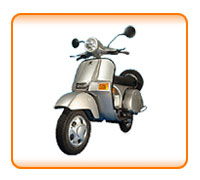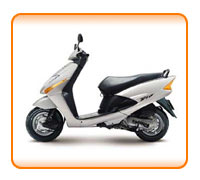Based largely on the R26, in 1960 the R27 added rubber mounts for the engine and boosted power to 18 hp (13 kW). The R27's 250 cc OHV vertical single was the only rubber-mounted thumper engine BMW ever produced, and was their last shaft drive single-cylinder motorcycle. The engine pumped out 18 hp (13 kW), the highest ever for a shaft-drive BMW single. BMW manufactured 15,364 R27 models (engine numbers 372 001 – 387 566 ) over the production years of 1960 to 1966. Some of the 1966 R27 models were sold as 1967 models because dealers in those years often would assign dates to BMW motorcycles when they sold them, and not necessarily when they were manufactured.
The vast majority of R27 motorcycles exported to the United States by BMW were black with white pinstriping. A few, however, were brought in by importer Butler & Smith in a color called Dover white, with black pinstriping. Why "Dover white?" Butler & Smith head honcho, Michael Bondy, had a 1942 Packard automobile in an off-white color called dover white. Bondy sent a sample of this color to BMW AG in Munich and asked that it be duplicated. BMW did copy the color, and Bondy ordered fifty motorcycles in that color. Today, BMW motorcycles in original dover white are a sought-after rarity.
BMW did things differently to other manufacturers. This is evident in the R27. Its enclosed shaft final drive is rare for a single cylinder motorcycle. But it also had a triangulated Earles front forkcrank and the final shaft were in line, and drive forces did not have to be run through a set of 90-degree gears. Also, the kick starter swung out sideways instead of parallel to the frame, so kick starting an R27 is a rather easy and danger-free affair. (named after English designer Ernest Earles); so the motorcycle had a front swingarm as well as a rear swingarm. When you squeezed the front brake lever hard not only did the front end not dive, it actually rose slightly. Thus, braking was a very steady activity, though the brakes were weak by today's standards. The engines crankshaft was laid out fore-to-aft, not side- to-side; also a rare feature. This way, the
[edit] Technical data
| R27 | |
|---|---|
| Engine Numbers | 372 001 – 387 566 |
| Design | Single cylinder with driveshaft |
| Engine | 4-stroke, 2 OHV |
| Transmission | Four-speed, left foot |
| Model years | 1960–1966 |
| Number manufactured | 15,364 |
| Bore | 68 mm (2.7 in) |
| Stroke | 68 mm (2.7 in) |
| Capacity | 247 cc |
| Power | 18 hp (13 kW) @ 7400 rpm |
| Compression ratio | 8.2:1 |
| Fuel efficiency | 60.3 miles per US gallon (3.90 L/100 km; 72.4 mpg-imp) DIN 70030 |
| Maximum speed | 81 mph (130 km/h) / with side car 56 mph (90 km/h) |
| Wheelbase | 54.3 in (1379.2 mm) |
| Curb weight | 357 lb (162 kg) |
| GVWR | 716 lb (325 kg) / with side car 1,058 lb (480 kg) |
| Tires front & rear | 3.25 x 18 |
| Battery | 6 volt, 9 Ah. |
| Tank capacity | 3.96 US gallon (15 liter) |
| Engine oil capacity | 2.6 US pint (1.2 liter) |
| Transmission capacity | 650 cc |
| Rear drive capacity | 125 cc |




 Bajaj Chetak, an Indian-made scooter, is counted among the most selling two-wheelers in semi-urban and rural markets. Chetak was holds and influential place in the two-wheeler market of India. It was an affordable way of transport for decades to millions of Indian families. The name of Bajaj Chetak Scooter has been derived from the legendary horse Chetak of the Indian warrior Rana Pratap Singh.
Bajaj Chetak, an Indian-made scooter, is counted among the most selling two-wheelers in semi-urban and rural markets. Chetak was holds and influential place in the two-wheeler market of India. It was an affordable way of transport for decades to millions of Indian families. The name of Bajaj Chetak Scooter has been derived from the legendary horse Chetak of the Indian warrior Rana Pratap Singh. Honda DIO the first motoscooter of India is a blend of style and performance. Honda Motorcycle and Scooter India Private Limited (HMSI) has comeup with its latest offering of Honda Dio giving comfort of a motorcycle and convenience of a scooter. This new model from Honda is youthful, energetic, sporty and innovative, perfectly matching the aspirations of young generation. DIO caters to those people who seek additional value keeping the basic needs; something different; two-wheeler style reflection of self and performance matching the driving conditions.
Honda DIO the first motoscooter of India is a blend of style and performance. Honda Motorcycle and Scooter India Private Limited (HMSI) has comeup with its latest offering of Honda Dio giving comfort of a motorcycle and convenience of a scooter. This new model from Honda is youthful, energetic, sporty and innovative, perfectly matching the aspirations of young generation. DIO caters to those people who seek additional value keeping the basic needs; something different; two-wheeler style reflection of self and performance matching the driving conditions.
